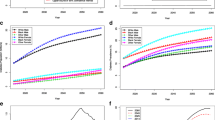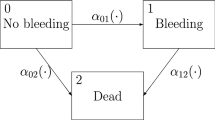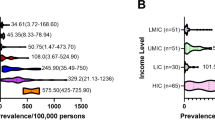Abstract
Diabetes is a common non-communicable disease affecting substantial proportion of adult population. This is true, especially in developing countries like India thereby posing a huge economic burden not only on the patient’s family but also on the nation as a whole. In this paper, we have employed a hidden Markov model to estimate the transition probabilities between three states of diabetes and applied it to real life data. A total of 184 Type 2 diabetic patients were included in this study. These patients are classified in different states on the basis of their available baseline value of Hemoglobin A1c (HbA1c). A HMM fits well to the data by capturing the misclassified states, and shows that the patients who had HbA1c ≥ 6.5% have minimum chance of recovery and substantially higher risk of complications. All the statistical analysis has been performed using the “Hidden Markov” package in R software.


Similar content being viewed by others
Abbreviations
- S:
-
Hidden state
- V:
-
Observed state
- L:
-
Likelihood function
- π:
-
Initial state distribution
- (S1, S2…SN):
-
Sequence of hidden state
- (V1,V2…Vm):
-
Sequence of observed state
- A:
-
Transition probability matrix
- B:
-
Emission probability matrix
- aij :
-
The probability of being in hidden state Sj at time (t + 1) given that the patient was in hidden state Si at time t
- bjk :
-
The probability of being in observed state k at time t given that the patient was in hidden state Sj at time t
- WHO:
-
World Health Organization
- GDM:
-
Gestational diabetes mellitus
- HMM:
-
Hidden Markov model
- HbA1c:
-
Glycated hemoglobin
- SD:
-
Standard deviation
- L:
-
Lower limit
- U:
-
Upper limit
- CI:
-
Confidence interval
References
American Diabetes Association (2017) 2. Classification and diagnosis of diabetes. Diabetes Care 40(Supplement 1):S11–S24
Bartolomeo N, Trerotoli P, Serio G (2011) Progression of liver cirrhosis to HCC: an application of hidden Markov model. BMC Med Res Methodol 11(1):38
Baum LE, Petrie T, Soules G, Weiss N (1970) A maximization technique occurring in the statistical analysis of probabilistic functions of Markov chains. Ann Math Stat 41(1):164–171
Goel K, Grover G, Sharma A, Bae S (2018) Multistate Markov model for predicting the natural disease progression of type 2 diabetes based on hemoglobin A1c. J Nephropharmacol 8(1):4
Grover G, Sabharwal A, Kumar S, Thakur AK (2019) On the estimation of misclassification probabilities of chronic kidney disease using continuous time hidden Markov models. J Nephropharmacol 8(1):e7
Hammerling JA (2012) A review of medical errors in laboratory diagnostics and where we are today. Lab Med 43(2):41–44
International Diabetes Federation (2017) IDF Diabetes Atlas Eighth Edition
Jackson CH, Sharples LD (2002) Hidden Markov models for the onset and progression of bronchiolitis obliterans syndrome in lung transplant recipients. Stat Med 21(1):113–128
Kaveeshwar SA, Cornwall J (2014) The current state of diabetes mellitus in India. Australas Med J 7(1):45
MacDonald IL, Zucchini W (1997) Hidden Markov and other models for discrete-valued time series, vol 110. CRC Press, Boca Raton
Malik VS, Popkin BM, Bray GA, Després JP, Willett WC, Hu FB (2010) Sugar-sweetened beverages and risk of metabolic syndrome and type 2 diabetes: a meta-analysis. Diabetes Care 33(11):2477–2483
Mohan V, Shanthirani S, Deepa R, Premalatha G, Sastry NG, Saroja R (2001) Intra‐urban differences in the prevalence of the metabolic syndrome in southern India–the Chennai Urban Population Study (CUPS No. 4). Diabetic Med 18(4):280–287
Palmer JR, Boggs DA, Krishnan S, Hu FB, Singer M, Rosenberg L (2008) Sugar-sweetened beverages and incidence of type 2 diabetes mellitus in African American women. Arch Intern Med 168(14):1487–1492
Rabiner LR (1989) A tutorial on hidden Markov models and selected applications in speech recognition. Proc IEEE 77(2):257–286
Rosen J, Solazzo M, Hannaford B, Sinanan M (2002) Task decomposition of laparoscopic surgery for objective evaluation of surgical residents’ learning curve using hidden Markov model. Comput Aided Surg 7(1):49–61
Sadeghifar M, Seyed-Tabib M, Haji-Maghsoudi S, Noemani K, Aalipur-Byrgany F (2016) The application of Poisson hidden Markov model to forecasting new cases of congenital hypothyroidism in Khuzestan province. J Biostat Epidemiol 2(1):14–19
Wild S, Roglic G, Green A, Sicree R, King H (2004) Global prevalence of diabetes: estimates for the year 2000 and projections for 2030. Diabetes Care 27(5):1047–1053
World Health Organization (1985) Diabetes mellitus. Report of a WHO study group. WHO Technical Report
Zare A, Mahmoudi M, Mohammad K, Zeraati H, Hosseini H, Naeini KH (2014) Assessing misdiagnosis of relapse in patients with gastric cancer in Iran Cancer Institute based on a hidden Markov multi-state model. Asian Pac J Cancer Prev APJCP 15(9):4109–4115
Author information
Authors and Affiliations
Corresponding author
Additional information
Publisher's Note
Springer Nature remains neutral with regard to jurisdictional claims in published maps and institutional affiliations.
Rights and permissions
About this article
Cite this article
Varshney, M.K., Sharma, A., Goel, K. et al. Estimation of transition probabilities for diabetic patients using hidden Markov model. Int J Syst Assur Eng Manag 11 (Suppl 2), 329–334 (2020). https://doi.org/10.1007/s13198-020-00950-7
Received:
Revised:
Published:
Issue Date:
DOI: https://doi.org/10.1007/s13198-020-00950-7




